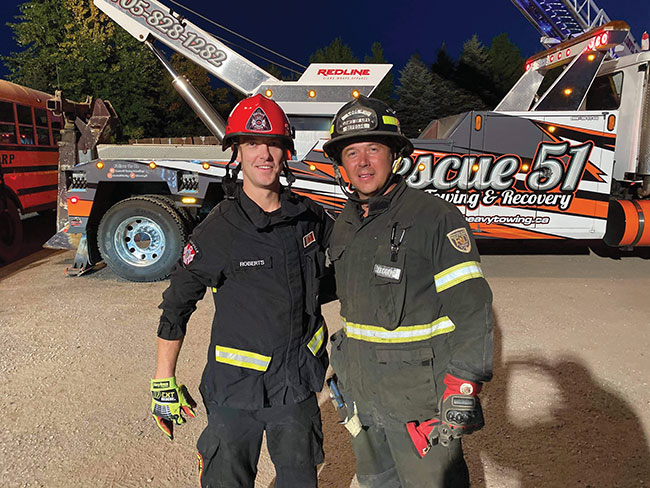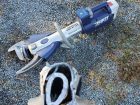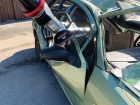
Extrication Tips: Pre-loading with Jason Defosse
Chad Roberts
Features Extrication Training It’s a great benefit to train and learn with industry leading experts like Jason Defosse. Photo credit: Chad Roberts
It’s a great benefit to train and learn with industry leading experts like Jason Defosse. Photo credit: Chad Roberts In my 2019 two-part series on exposing vehicle weakness, I touched on ultra-high strength steels and some of the ways we can manipulate our way around them altogether. But, like anything in life, we can’t always avoid the hard road. Sometimes you just have to meet something head on. So, what is our plan when we deal with the newer model vehicles that are quickly becoming regulars on our accident scenes? Sooner or later we have to go through the wall and not always around it. Ultra-high strength steel is becoming more prevalent all over new vehicles and we can’t simply turn a blind eye or revert to plan B. While trying many different approaches I found some success, but never consistent enough to truly make a solid conclusion on what worked best. It was until I met up and trained with one of our industry experts, Jason Defosse from Code4 Fire & Rescue, who showed me a tried and proven method for moving, cutting and manipulating these super metals.
My past articles were about exposing a vehicle’s weaknesses. After meeting up with Defosse, my perspective changed from exposing weaknesses to creating them. Enter the method of “pre-loading”. What is this magical and wonderful addition to our current array of extrication knowledge? Let’s look at it from a fire service related example. Think about rope and its extreme level of strength. Every few years our rope rescue industry is coming out with new ways to make rope smaller, yet stronger and more efficient than previous options. The same theory lies true with the automotive industry and its constant advancement in new steel technology. Every year governing bodies are demanding more fuel efficiency and emission reduction from the manufacturers. While on the other hand the same bodies and consumers alike are demanding more safety. So where do these demands get met. Enter synthetic ultra high strength steel materials that deliver massive strength all the while becoming lighter and more efficient, therefore reducing emissions.
So, how do we keep up? Let’s go back to the rope theory. When inspecting rope, we are always looking for every little deformity, abrasion or deficiency that will affect the overall collective strength of the rope. This same theory is what Defosse introduced me to with the theory of pre-loading high strength steels. Defosse has always taught that a great way to approach new age extrication is by creating inches, angles and egress instead of the large gaping holes we have done in the past. Pre-loading not only creates these initial openings and spaces for our patients, but it also does something just as important when facing high strength steels. While vehicles of the past were cut by our cutters, newer vehicles of today and future are so strong they need to be compressed and fractured. By using our spreaders and rams we can create the pre-loading of these high strength steels which will ultimately enable our cutters to compress and fracture more efficiently and safely. To better explain these industry leading theories, let’s take a look at a couple great options in regards to pre loading.
Our first option is a technique that a lot of us already do but may not fully understand the advantages that it creates for us. By placing the spreader in the open window of the front or rear door and spreading the window open we are not only gaining a positive purchase point. We are also creating initial space and relief for our patients while providing a pre load to the steel located in the top of our B pillar and potentially the top of the A or C pillar depending on which window you are spreading. Now that this steel has been weakened by our spread, we can leave the spreader in place while we bring in our cutter to eliminate the weakened pillar attachment. From there we can move into a rear door pop with our original purchase point created for a quick side out. Or if we need to create more space for our patient we can use our spreader and ram in the cut at the top of the A pillar to perform a side out maneuver by driving the B pillar towards the ground and away from our patients.
Another quick example of how this pre-loading can be beneficial for us on scene is by starting with our rams this time. After removing our front door fully and we are able to do a quick assessment of our patient we may find a dash lift or push maneuver is needed to create the space needed for a safe removal. By using our ram and placing one head at the base of the B pillar and pushing off the mid A pillar with our other end before any relief cuts are made we are pre-loading the lower and higher A post cuts needed in our dash displacement all while providing initial space and patient relief. With the steel now under tension and weakened, we can now make much easier cuts with our cutters. From here we can continue on with our ram and spreaders in conjunction to relieve our dash from our patients, remove the ram and have a great opening for removal.
Pre-loading is nothing new to the auto extrication world. It’s something that we’ve been doing since the introduction of hydraulic tools. However, with the introduction of ultra and advanced high strength steels, Defosse opened our eyes to better understand and use this technique. Not only are we making these cuts easier on our tools, we are also enhancing patient and rescuer safety as we are reducing the chance of violently shattering blades and influencing tool travel by taking advantage of the pre loading our tools can create.
Chad Roberts is a firefighter in Oakville, Ont. He is a member of the Oakville extrication team and competes and trains across North America. Contact Chad at chadroberts12@gmail.com.
Print this page

